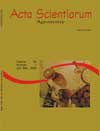<b>Evaluation of non-volatile compounds in different cultivars of coffee cultivated in southern Minas Gerais</b> - DOI: 10.4025/actasciagron.v31i1.6629
Keywords:
Coffea Arabica, breeding, chemical composition, chlorogenic acids, caffeine, trigonelline
Abstract
This research was conducted to evaluate trigonelline, chlorogenic acids (5-CQA) and caffeine contents in grains of different cultivars of coffee (Coffea arabica L). The cultivars were colleted at the Experimental Farm of the EPAMIG-Lavras, Minas Gerais state, during 2005/2006. The experimental design was completely randomized with eight cultivars of coffee: Oeiras MG 6851, Acaiá Cerrado MG 1474, Catuaí Vermelho IAC 99, Rubi MG 1192, Topázio MG 1190, Mundo Novo IAC 379-19, Catucaí Amarelo 2 SL and Catuaí Amarelo IAC 62. After the harvest on cloth, the fruits were depulped and washed. After the removal of parchment, the grains were dried until reaching 11%-12% moisture. The samples were submitted to caffeine, trigonelline and 5-CQA analysis by HPLC. The cultivars showed differences in the non-volatile compounds under same crop management environment for all cultivars. Catuaí Amarelo IAC 62 and Rubi MG 1192 showed the highest trigonelline contents; Catuaí Amarelo IAC 62, Catuaí Vermelho IAC 99, Rubi 1192 and Oeiras MG 6851 showed the highest 5-CQA contents; Oeiras MG 6851 and Mundo Novo IAC 379-19 cultivars showed the lowest caffeine content.Downloads
Download data is not yet available.
Published
2009-03-19
How to Cite
Malta, M. R., & Chagas, S. J. de R. (2009). <b>Evaluation of non-volatile compounds in different cultivars of coffee cultivated in southern Minas Gerais</b> - DOI: 10.4025/actasciagron.v31i1.6629. Acta Scientiarum. Agronomy, 31(1), 57-61. https://doi.org/10.4025/actasciagron.v31i1.6629
Issue
Section
Crop Production
DECLARATION OF ORIGINALITY AND COPYRIGHTS
I Declare that current article is original and has not been submitted for publication, in part or in whole, to any other national or international journal.
The copyrights belong exclusively to the authors. Published content is licensed under Creative Commons Attribution 4.0 (CC BY 4.0) guidelines, which allows sharing (copy and distribution of the material in any medium or format) and adaptation (remix, transform, and build upon the material) for any purpose, even commercially, under the terms of attribution.
2.0
2019CiteScore
60th percentile
Powered by 

2.0
2019CiteScore
60th percentile
Powered by 



















































